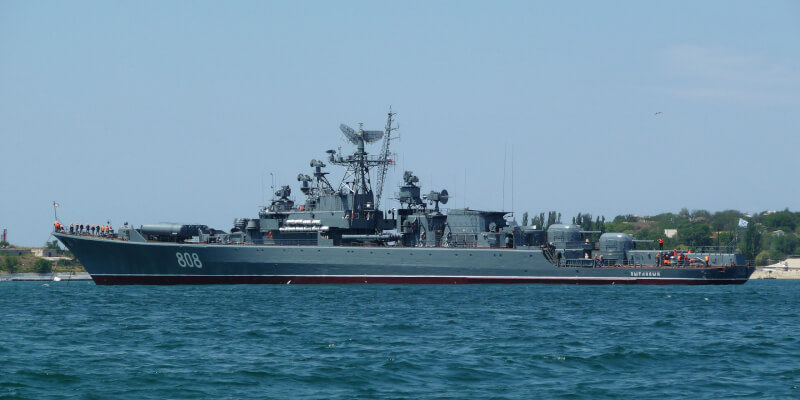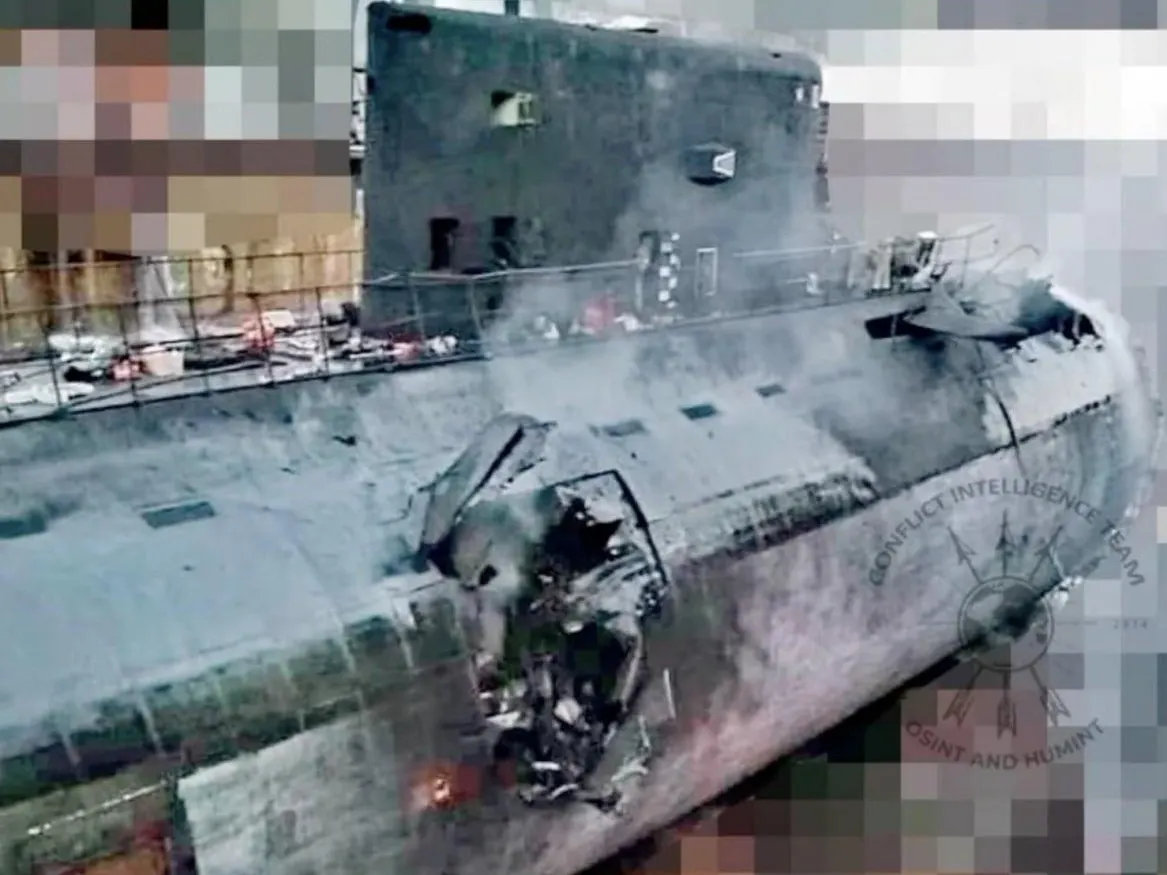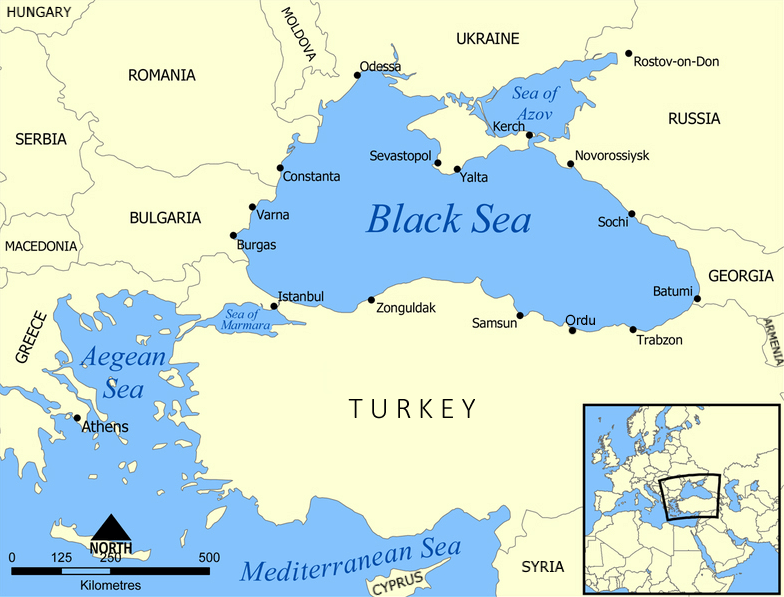
The Russian Krivak II-class frigate Pytlivyy sits at anchor in Sevastopol Bay in 2009. An unnamed frigate of this type was the last to leave the occupied port of Sevastopol on July 15.
[Wikimedia]
“From a pure maritime perspective, this is the last in a long list of humiliations suffered by the Black Sea Fleet since the 2022 invasion,” Tom Sharpe wrote for the London Telegraph.
With no navy to speak of, Ukrainian military have launched land-based missile and drone attacks, as well as sea drones, to great effect against maritime targets. Almost a third of Russia’s Black Sea fleet—27 of 80 vessels, including a submarine—is believed to have been sunk or disabled since Moscow’s forces invaded Ukraine in February 2022.
The British Defence Ministry declared the Black Sea Fleet “functionally inactive” in March 2024.
Formed in 1783, the Black Sea fleet was once considered Russia’s main force in Crimea, but it has now entirely been chased away and relocated after its deputy commander was killed in action at Mariupol in March 2022 and land-based Ukrainian forces sank the fleet’s flagship three weeks later.

A Ukrainian cruise missile knocked out the Russian submarine Rostov-on-Don in a September 2023 nighttime raid on the anchorage in Sevastopol.
[Social Media]
Moskva’s sinking was a major blow to Russian prestige and a symbolic and practical victory for Kyiv. It was the only ship in the fleet equipped with anti-aircraft missile systems capable of defending an entire naval formation from air attack. Its loss rendered the fleet incapable of operating freely in the northwestern part of the Black Sea and plans for an amphibious landing near Odesa were abandoned.

Warships of Russia’s Black Sea fleet blockaded Ukrainian ports and shelled cities before Ukrainian missile and drone attacks forced it into a withdrawal.
[Alexander Demianchuk/TASS]
“From a pure maritime perspective, this is the last in a long list of humiliations suffered by [Russia’s] Black Sea Fleet since the 2022 invasion.”
Russia annexed Crimea from Ukraine in 2014, adopting its Sevastopol naval base as the primary headquarters for the Black Sea fleet.
Besides multiple tugs, landing craft and logistics vessels, Ukraine has damaged or destroyed Russian patrol boats, landing ships, a submarine, a corvette, two missile-carrying warships, numerous amphibious vessels and a high-speed assault boat. Many of the strikes were recorded on video.
A July 31, 2022, drone strike at Sevastopol wounded several people and forced the cancellation of Russian Navy Day commemorations. Nine days later, western officials confirmed that strikes at Crimea’s Saky airbase took out more than half the fleet’s combat jets. Saky has been hit multiple times since.
On Sept. 13, 2023, a Ukrainian Storm Shadow cruise missile knocked out the Russian fleet’s submarine Rostov-on-Don in a nighttime raid on the anchorage in Sevastopol. The strike didn’t just damage the Kilo-class boat in its drydock, it blew it up from within, puncturing the 3,100-ton boat amidships before exploding inside.
A month later, satellite imagery indicated that Russia had begun to relocate some of its naval ships away from their adopted Crimean port.
With July’s departure of the last Krivak-class patrol frigate, Basil Germond, an expert in international security at Britain’s Lancaster University, told Business Insider that the Black Sea fleet “has lost control of the Black Sea.”
Brian Glyn Williams, a history professor at UMass Dartmouth, says the Ukrainian successes at sea “have launched a revolution in weapons and tactics that offer both lessons and warnings for the world’s navies.”
Writing for The Conversation, Williams called it “a lesson in how weaker powers can take advantage of innovative thinking and new technology to defeat more powerful opponents.”
Soon after Russian forces first invaded in 2022, Ukrainians began designing and building what Williams described as “the world’s first combat-deployed sea drone.”

The Black Sea is among the world’s most strategic bodies of water.
[ Wikimedia]
With the departure of the last Krivak-class vessel, an expert in international security told Business Insider that the Black Sea Fleet “has lost control of the Black Sea.”
Known as the Magura-V5, “this explosive-laden vehicle was designed to do what many thought impossible: travel long distances across stormy seas, undetected by radar, and deliver 500 to 700 pounds of explosives to distant targets.”
Its first test was an Oct. 19, 2022, night raid on the naval base at Sevastopol.
“Six to eight remotely guided Magura sea drones entered the harbor and damaged the new flagship for the Russian Black Sea Fleet, the frigate Admiral Makarov, and a minesweeper,” Williams reported. “One naval combat analyst described the first-ever sea drone assault on a naval base as ‘a turning point in naval strategy.’”
Following this victory, the Ukrainians began deploying the drones more widely. Cameras on board the remotely guided craft sent back imagery of their attacks on the variety of Black Sea fleet vessels. In one typical strike, remotely piloted drones repeatedly strike and sink the Ivanovets, a missile corvette.
After the Russians withdrew, Williams says the Ukrainians developed longer-range sea drones known as Seababies and Mamais, which can travel nearly 800 kilometres across the Black Sea to strike Russian vessels around the new base at Novorossiysk. The Seababies have also deployed naval mines, sinking four more ships.
Russian warships subsequently sought refuge in the more protected Sea of Azov.
The Russian withdrawal has secured Ukraine’s access to export routes, enabling commercial vessels to move goods such as the country’s vital grain commodity.
“The Ukrainians’ sea drone successes are not only cause for celebration in Ukraine,” wrote Williams, “but demonstrate the potential of new ideas and equipment to reshape naval warfare and the balance of military power at sea.”
President Vladimir Putin told navy chiefs in June that Russia’s fleet had been replenished in recent years and that a major modernization was underway, including steps to “increase the combat stability of the fleet” and strengthen it.
Advertisement





















